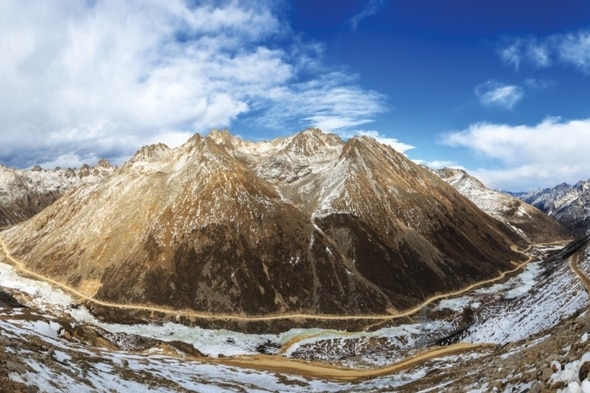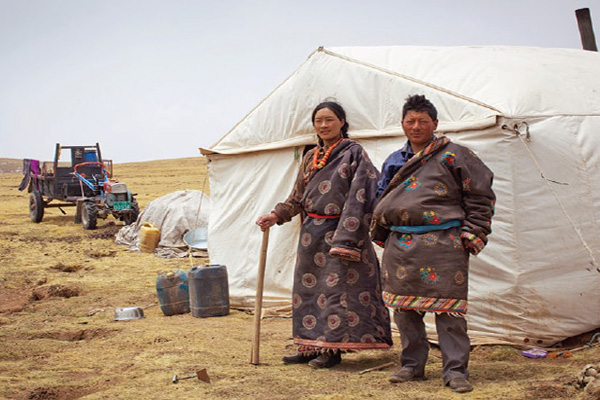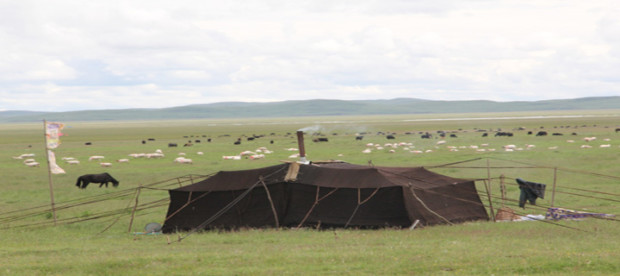The Surprisingly Early Settlement of the Tibetan Plateau
By Jane Qiu
Scientists thought people first set foot on the frozen Tibetan Plateau 15,000 years ago. New genomic analyses suggest multiplying that figure as much as fourfol
 Genetic analysis suggests that humans have continuously inhabited the Tibetan Plateau as far back as the last ice age. Credit: Getty Images
Genetic analysis suggests that humans have continuously inhabited the Tibetan Plateau as far back as the last ice age. Credit: Getty Images
The first humans who ventured onto the Tibetan Plateau, often called the “roof of the world,” faced one of the most brutal environments our species has ever confronted. At an average elevation of more than 4,500 meters, it is a cold and arid place with half the oxygen present at sea level. Although scientists had long thought no one set foot on the plateau until 15,000 years ago, new genetic and archaeological data indicate that this event may have taken place much earlier—possibly as far back as 62,000 years ago, in the middle of the last ice age. A better understanding of the history of migration and population growth in the region could help unravel the mysteries of Tibetans’ origin and offer clues as to how humans have adapted to low-oxygen conditions at high altitudes.
As reported in a recent study in the American Journal of Human Genetics, researchers got a better grasp of the plateau’s settlement history by sequencing the entire genomes of 38 ethnic Tibetans and comparing the results with the genomic sequences of other ethnic groups. “It has revealed a complex patchwork of prehistoric migration,” says Shuhua Xu, a population geneticist at the Chinese Academy of Sciences’ Shanghai Institutes for Biological Sciences. “A big surprise was the antiquity of Tibetan-specific DNA sequences,” Xu says. “They can be traced back to ancestors 62,000 to 38,000 years ago, possibly representing the earliest colonization of the plateau.”

Some nomadic people in the region still follow a traditional way of life. Credit: Edwina Deacon Getty Images
As an ice age tightened its grip after that first migration, genetic mixing between Tibetans and non-Tibetans ground to a halt for tens of thousands of years—suggesting that movement into Tibet dropped to a minimum. “The migration routes were probably cut off by ice sheets,” Xu says. “It was simply too harsh even for the toughest hunter-gatherers.” But about 15,000 to 9,000 years ago—after the so-called last glacial maximum (LGM), when the ice age was at its harshest and Earth’s ice cover had reached its peak—thousands flocked to Tibet en masse. “It’s the most significant wave of migration that shaped the modern Tibetan gene pool,” Xu says. This meshes well with several independent lines of evidence showing that Tibetans began to acquire genetic mutations that protected them from hypoxia 12,800 to 8,000 years ago.
Xu’s team was the first to sequence the entire Tibetan genome, and “the resolution is really impressive,” says archaeologist Mark Aldenderfer of the University of California, Merced, who was not involved in the research. The study, he adds, “provides fine details of how different populations from various directions may have combined their genes to ultimately create the people that we call Tibetans.” It shows that 94 percent of the present-day Tibetan genetic makeup came from modern humans—possibly those who ventured into Tibet in the second wave of migration—and the rest came from extinct hominins. The modern part of the Tibetan genome reflects a mixed genetic heritage, sharing 82 percent similarity with East Asians, 11 percent with Central Asians and 6 percent with South Asians.
In addition, Xu’s team identified a Tibetan-specific DNA segment that is highly homologous to the genome of the Ust’-lshim Man (modern humans living in Siberia 45,000 years ago) and several extinct human species, including Neandertals, Denisovans and unknown groups. The segment contains eight genes, one of which is known to be crucial for high-altitude adaptation. Xu suspects that a hybrid of all these species may have been the common ancestor of the pre-LGM population on the plateau.
The study also reveals a startling genetic continuity since the plateau was first colonized. “This suggests that Tibet has always been populated—even during the toughest times as far as climate was concerned,” Xu says. That idea contradicts the commonly held notion that early plateau dwellers would have been eliminated during harsh climate intervals, including the LGM, says David Zhang, a geographer at the University of Hong Kong, who was not involved in Xu’s work. Aldenderfer and others contend that parts of the plateau could have provided a refuge for people to survive the ice age. “There were plenty of places for [those early populations] to live where local conditions weren’t that bad, such as the big river valleys on the plateau,” he says.
Also supporting the antiquity of the peopling of Tibet is a study presented at the 33rd International Geographical Congress last summer in Beijing, where a team unveiled the plateau’s earliest archaeological evidence of human presence—dating to 39,000 to 31,000 years ago. The site, rich with stone tools and animal remains, lies on the bank of the Salween River in the southeastern Tibetan Plateau.
Different lines of evidence are now converging to point to much earlier and much more persistent human occupation of the plateau than previously thought, Aldenderfer says. But he notes that pieces are still missing from the puzzle: “More excavations are required to close those gaps.”
This article was originally published with the title “Ice Age Tibetans”
| Scientific American March 2017 Issu



comment 0